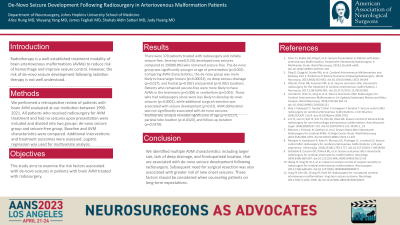De-Novo Seizure Development Following Radiosurgery in Arteriovenous Malformation Patients
De-novo Seizure Development Following Radiosurgery in Arteriovenous Malformation Patients
Friday, April 21, 2023


Wuyang Yang (he/him/his)
Chief Resident (PGY6)
Johns Hopkins University School of Medicine
Baltimore, Maryland, United States
ePoster Presenter(s)
Introduction: Radiotherapy is a well-established treatment modality of brain arteriovenous malformations (AVMs) to reduce risk of hemorrhage and improve seizure control. However, the risk of de-novo seizure development following radiation therapy is not well understood. This study aims to examine the risk factors associated with de-novo seizures in patients with brain AVM treated with radiosurgery.
Methods: We performed a retrospective review of patients with brain AVM evaluated at our institution between 1990-2021. All patients who received radiosurgery for AVM treatment and had no seizures upon presentation were included and divided into two groups: de-novo seizure group and seizure-free group. Baseline and AVM characteristics were compared. Additional interventions and treatment outcomes were assessed. Logistic regression was used for multivariate analysis.
Results: There were 370 patients treated with radiosurgery and initially seizure-free. Seventy-one(19.2%) developed new seizures compared to 299(80.8%) who remained seizure-free. The de-novo group was significantly younger at age of presentation (p=0.002). Comparing AVM characteristics, the de-novo group was more likely to have larger lesions (p=0.00013), no deep venous drainage (p=0.017), and frontal (p=0.001) and parietal (p < 0.001) locations. Patients who remained seizure-free were more likely to have AVMs in the brainstem (p=0.006) or cerebellum (p=0.001). Those who had radiosurgery alone were less likely to develop de-novo seizures (p=0.0001), while additional surgical resection was associated with seizure development (p=0.01). AVM obliteration was not significantly associated with de-novo seizures. Multivariate analysis revealed significance of age (p=0.0117), parietal lobe location (p=0.0320), and follow-up duration (p=0.0370).
Conclusion : We identified multiple AVM characteristics including larger size, lack of deep drainage, and frontoparietal location, that are associated with de-novo seizure development following radiosurgery. Subsequent need for surgical resection was also associated with greater risk of new onset seizures. These factors should be considered when counseling patients on long-term expectations.
Methods: We performed a retrospective review of patients with brain AVM evaluated at our institution between 1990-2021. All patients who received radiosurgery for AVM treatment and had no seizures upon presentation were included and divided into two groups: de-novo seizure group and seizure-free group. Baseline and AVM characteristics were compared. Additional interventions and treatment outcomes were assessed. Logistic regression was used for multivariate analysis.
Results: There were 370 patients treated with radiosurgery and initially seizure-free. Seventy-one(19.2%) developed new seizures compared to 299(80.8%) who remained seizure-free. The de-novo group was significantly younger at age of presentation (p=0.002). Comparing AVM characteristics, the de-novo group was more likely to have larger lesions (p=0.00013), no deep venous drainage (p=0.017), and frontal (p=0.001) and parietal (p < 0.001) locations. Patients who remained seizure-free were more likely to have AVMs in the brainstem (p=0.006) or cerebellum (p=0.001). Those who had radiosurgery alone were less likely to develop de-novo seizures (p=0.0001), while additional surgical resection was associated with seizure development (p=0.01). AVM obliteration was not significantly associated with de-novo seizures. Multivariate analysis revealed significance of age (p=0.0117), parietal lobe location (p=0.0320), and follow-up duration (p=0.0370).
Conclusion : We identified multiple AVM characteristics including larger size, lack of deep drainage, and frontoparietal location, that are associated with de-novo seizure development following radiosurgery. Subsequent need for surgical resection was also associated with greater risk of new onset seizures. These factors should be considered when counseling patients on long-term expectations.
